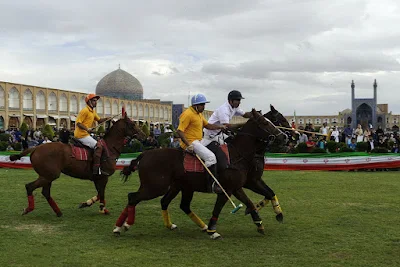While the sport of
polo is older than recorded history, we know that its origins are in the
inspirational relationship between humans and horses. The art of polo is
distinctly Persian and it is thought to have originated in Persia over 2000
years ago. The special bond and the unique blending of athletic talents between
horse and rider have helped polo evolve into The Sport of Kings. Game played on horseback between two teams of four players
each who use mallets with long, flexible handle to drive a wooden ball down a
grass field and between two goal posts. The
match is divided into chukkas, each lasting 7 minutes, with an interval of 3
minutes between each one. The object of Polo is for a team to score more points
than its opposition, thus winning the game. Each team attempts to move the ball
into the opposition's half of the pitch with the aim of eventually hitting it
through the goal to score. Each team of four is made up of attackers and
defenders, but realistically all members of a polo team are expected to be
flexible and make any play whether offensive or defensive and change position as
necessary to benefit the team. Today, the oldest of equestrian sports is
finding a shiny, new vitality among the young people in the whole world. We are
so thrilled to announce that, Polo has been officially registered as an Iranian
sport on UNESCO's list of intangible cultural heritage in December 2017.
 |
| Two polo teams are competing with each other in Naqshe jahan Square of Isfahan, Iran |

Polo’s recognition as an Iranian sport on UNESCO’s Intangible Cultural Heritage list is a proud moment for equestrian history. With its origins dating back over 2,000 years in Persia, polo has evolved into a globally admired sport, showcasing the deep bond between horse and rider. Its growing popularity among young players worldwide is a testament to its timeless appeal. A truly remarkable achievement for Iran’s rich sporting heritage!
ReplyDeletefootball predictions
It’s fascinating to see polo recognized by UNESCO as an Intangible Cultural Heritage, especially considering its deep Persian roots. The harmony between rider and horse, along with the sport’s strategic and athletic demands, truly makes it timeless. It’s exciting to witness a resurgence of interest among young people worldwide, helping to preserve this ancient equestrian art. Polo isn’t just a sport—it’s a cultural legacy that continues to inspire across generations.
ReplyDeleteminecraft 1.22 download apk
This comment has been removed by the author.
ReplyDeleteWow, I never knew Polo had Iranian roots and made it to UNESCO’s list—super cool! The sport’s mix of skill and power reminds me of training with a hand gripper—precision and strength matter. Respect to Iran for preserving such a legendary heritage sport.
ReplyDeletePolo’s inclusion on UNESCO’s list truly highlights Iran’s deep cultural roots. This historic sport carries prestige similar to legendary fighters like Buakaw, whose record reflects discipline and tradition. Just like the Buakaw Record inspires fighters, polo preserves Iran’s rich heritage for future generations.
ReplyDelete